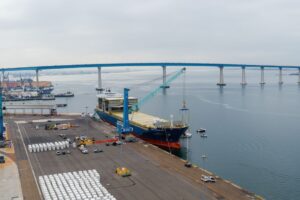With a portfolio of energy projects spanning across the world, Shell is today recognised for its expertise, knowledge, and proven deep-water technologies, which it utilises to unlock new resources to deliver safe and efficient energy for the globe. It is this deep knowledge of the world’s energy sector that began Shell’s deep-water development era in the Gulf of Mexico (also known as the Gulf of America) more than 40 years ago. Today, Shell is the leading deep-water oil and gas producer in the Gulf of Mexico, playing a critical role in delivering deep-water projects that are powering progress across the region.
Check out the article in the magazine below:
Shell’s operations in the Gulf of Mexico began when a team of engineers, scientists and explorers came together to reimagine the future of the region’s offshore oil and gas production. The first platform developed was the Cognac Platform in 1978, which exemplified Shell’s expertise in the deep-water development field as it was the first company to produce resources at water depths of 1000 feet (ft). From the establishment of this platform, it was clear that Shell was to be a leading player in the Gulf of Mexico’s development.
Over the years, Shell has continued to invest in profitable and carbon-competitive oil and gas projects achieved through its exceptional technological milestones across the design, construction, and operation of world-class oil and gas producing assets operating at water depths. It is Shell’s innovative approach to deep-water development, often using standardised designs, which has allowed it to remain so competitive. By standardising its operations, Shell can reduce costs and provide quicker returns, and in turn, Shell’s production across the Gulf of Mexico now ranks among the lowest greenhouse gas (GHG) intensity in the world for the production of oil. It is this focus on decarbonisation alongside its project delivery that has set Shell up to deliver vital energy resources across the Gulf region, supported by innovation, research, and development focused on delivering energy now and for the future.
As the largest operator in the Gulf of Mexico, Shell operates world-class oil and gas projects, including one of the world’s deepest offshore drilling and production facilities, the Perdido Platform. The platform operates at water depths up to 2,450 metres, highlighting Shell’s ability to deliver ultra-deep-water exploration at such depths. Perdido began production in 2010, and at its peak and can produce up to 125,000 barrels of oil equivalent per day (boepd). The platform is operated by Shell, who hold a 35% working interest, with joint venture partners of Chevron (37.5%) and BP (27.5%). The platform acts as a hub and enables the development of the Great White, Tobago, and Silvertip fields, extracting oil from 35 subsea wells.
However, in recent years, Shell has been developing new and innovative platforms, which are focused on decarbonising its deep-water operations. One of the most notable recent developments for this is the Vito Platform, located 150 miles from New Orleans. The Vito Platform has brought a new era for Shell’s offshore production across the Gulf, with the platform designed to be much smaller and more compact than a typical offshore platform. With Vito being roughly 70% of the size of the platforms we typically see for offshore oil and gas production, the platform provides Shell with a more environmentally friendly development for energy production as it requires less steel, cables, space and power to operate. Therefore, Vito greatly reduces the impact of the development and operation of the platform on the environment. To further enhance its sustainability, Vito is expected to see a reduction in its estimated electrical power load consumption across the platform, whilst also delivering more efficient waste heat recovery units. The platform will have optimised turbines to better fit the required load demand needed to operate the smaller Vito. Production began at Vito in February 2023 and now serves as a clear blueprint for Shell to deliver deep-water projects across the Gulf of Mexico to help improve its platform delivery and development to be both economically and environmentally enhanced.
Building on the success of Vito, Shell began work on the Whale Platform, the second of three planned oil and gas platforms, which will feature a similar compact size to the Vito Platform. In contrast to many platforms along the Gulf of Mexico, Whale is roughly only a 6th of the size of the tallest offshore platform in the world. The Whale platform has been designed as a close replica of Vito, but the platform is built to withstand 30-metre waves that often occur during hurricane season. The platform was installed in February 2024, located within the Whale oil and gas fields at a depth of 2,600 metres. The platform is operated by Shell Offshore Inc., a subsidiary of Shell Plc, who have a 60% interest in the platform, alongside Chevron (40%).
In January, Shell Offshore Inc. announced that production had commenced from the Whale Platform. The platform is estimated to have a peak production capacity of 100,000 boepd, with an estimated recoverable resource volume of 480 million barrels of oil (boe). Announcing the start of production from Whale was Zoë Yujnovich, Shell’s Integrated Gas and Upstream Director, outlined that “Whale demonstrates our focus on driving more value with less emissions from our Upstream business as we deliver the energy people need today. Yujnovich continues, “It [Whale] will make a significant contribution to our commitment to bring projects online, with a total peak production of more than 500,00 barrels of oil equivalent per day from 2023 through 2025”. With a significant production capacity expected from Whale over the coming years, this highlights the leading role Shell is playing in developing energy developments across the Gulf of Mexico.
However, with the Whale Platform replicating 99% of the hull design and 80% of the topside from Vito, Whale enhances Shell’s deep-water development, where its oil production has among the lowest GHG intensity in the world. Whale features energy-efficient gas turbines and compression systems, which operate with 30% lower GHG intensity over its lifecycle compared to Vito. This development exemplifies Shell’s continual movement towards decarbonising its deep-water operations and ensuring that with every new development, it is building upon this goal.
Across its platforms in the Gulf of Mexico, Shell is proactively managing the greenhouse gas intensity of its deep-water operation through innovative project design, efficient operations, and strategic handling of late-life assets. In fact, Shell has achieved a 40% reduction in methane emissions in the Gulf of Mexico since 2016, and in 2023, Shell’s Gulf of Mexico emissions were 5% below its planned target, with intensity levels 9% below expectations. This continual movement towards decarbonisation is underpinned by Shell’s constant investment in research and development through collaboration with more than 25 universities and research centres. This research helps Shell to continually develop its project construction, development and delivery to ensure that each platform or energy development is working towards the global company’s long-term investment towards profitable and carbon competitive oil and gas projects across the Gulf of Mexico.
Across the Gulf of Mexico, Shell is playing a leading role in developing vital platforms that are enhancing the region’s vital oil and gas deposits to bring this energy to market. However, their primary focus throughout this is to deliver energy projects that optimise its research, development and expertise to deliver energy resources in a sustainable way. With compact and energy advanced platforms such as Vito and Whale, Shell is delivering vital energy with a low GHG emission intensity that helps deliver the energy needed today, whilst protecting the planet for the future.








